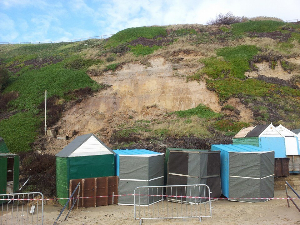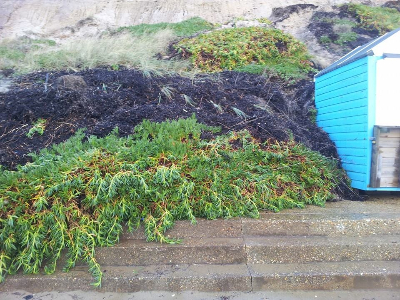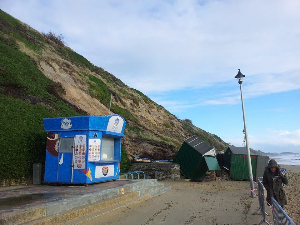Hottentot fig is an increasingly-common sight on British coastlines, and a rather attractive one. The problem is that it outcompetes native coastal vegetation, displacing rare species like the sand lizard (Lacerta agilis), and could even be adding to coastal erosion in some places.
Everyone likes to see attractive flowers in bloom, but to the conservationist this is sometimes tinged with the knowledge that the flowers in question are of an alien species that we could do without in the UK. It's not the fact that the species is alien per se, but the fact that it is invading at the expense of native species and seminatural habitats.
Two major pest plants spring to mind here on the Dorset coast: rhododendron (Rhododendron ponticum) and Hottentot fig (Carpobrotus edulis). Both are alien invaders brought here by Victorian gardeners and fanciers of their attractive flowers and foliage. Both are wreaking devastation across large estates and coastlines in Britain, ruining habitats such as lowland heathland and coastal grassland.
Hottentot fig, as the name suggests, is a South African species; but it survives equally well on British coastlines, as long as the weather is mild and generally frost-free. The southwest peninsula of England is one such coastline, and the species is rampant here, in Cornwall, Devon and Dorset in particular. It is a peculiar plant, with composite pink flowers similar to the Mesembryanthemum that gardeners will be familiar with. However, its leaves are thick, he avy and succulent, with an unmistakeable triangular cross-section. Nothing else can be confused with Hottentot fig, especially when you see a huge mat completely covering a stretch of cliff, at the expense of all native vegetation.
avy and succulent, with an unmistakeable triangular cross-section. Nothing else can be confused with Hottentot fig, especially when you see a huge mat completely covering a stretch of cliff, at the expense of all native vegetation.
Its invasiness and powerful dominance over native species and habitats is well-known, but its potential impact on the geomorphology and risk-management of British coastlines - especially 'soft' cliffs - is less well known. A recent landslide at Southbourne cliffs in Bournemouth offers a new insight. It involved a stretch of cliff that was covered in Hottentot fig, and the sand and gravel geology seems to have failed under the weight of the vegetation as much as the weight of the slipped substrate.
On the night of 21-22 December 2013, following days of persistent rain and strong winds, a section of approximately 30x30m of cliff between Gordon's Steps and Fisherman's Walk collapsed. The cliff has a scar now, showing that about 30-50cm of topsoil and sand sheered off it, and slipped down to the promenade below. Easily visible among the jumbled mass is a large heap of Hottentot fig, including dead (frost-damaged?) material.
The landslide occurred at night, which is lucky, as it destroyed six beach huts before covering the promenade. The area was quickly cordoned off with hazard tape, although this did not prevent some curious locals from clambering around the tumbled beach huts while I was there on 22/12/13. The beach huts had since been removed by m y last visit (27/12/13), but the landslip debris remained in place, still cordoned off.
y last visit (27/12/13), but the landslip debris remained in place, still cordoned off.
The question is: was Hottentot fig partly to blame for the landslide? Given how heavy this plant is, the answer seems to be 'yes'.
In the 12 years I have lived in Bournemouth, I have never seen a landslide of this magnitude anywhere on the eight miles (13km) of cliffs on the Poole Bay coastline, but I have had major concerns about the growing Hottentot fig problem for other reasons. Indeed, I have advised Bournemouth Borough Council's Parks and Countryside team of my concerns over the years, and they are very sympathetic. The problem is partly a lack of funds, and partly a lack of an easy solution.
Frost occasionally kills significant patches of Hottentot fig on Bournemouth cliffs, but its inexorable rampage continues, and the remaining patches of native marram grass (Ammophila arenaria) dwindle each year, with much wringing of hands among conservationists. Goat grazing is one management option that has been considered, but the cost and practicalities of fencing are a major constraint. My preference would be herbicide spraying, followed by manual rolling of the dead Hottentot fig mat down the cliffs, to be removed on flat-bed trucks at the bottom. Rapid re-seeding with marram grass - the classic dune stabiliser - would be essential, and the fig removal must be done at the right time of year.
I'd like to see a Council-led investigation to determine whether landslip-exacerbation is a real problem here; a new addition to the growing charge-sheet against Hottentot fig in the UK. As well as a general interest in coastal sand dunes and lowland heathlands, I have a particular interest in their native reptiles, including the sand lizard. This species has been lost from large stretches of the Poole Bay coastline, partly due to historic cliff re-profiling. The invasion of Hottentot fig along this coastline is the latest and most pervasive problem, and one reason why reintroduction is not possible on some stretches. The possibility that Hottentot fig might be contributing to cliff erosion is a new and worrying turn.
There are pressing questions. Cou ld there be more landslides? Where will the next one occur? Will it be an area of cliff covered in Hottentot fig? Can we predict high-risk areas? We don't really know the answers, but the latent risk should not be taken lightly – including the risk to humans. A landslide might happen in the daytime while beach-hut users and promenade strollers are present. An urgent risk-assessment would therefore seem wise, and is presumably a requirement of the local 'Shoreline Management Plan'. We can only hope that the Council, which has responsibility for Poole Bay's Shoreline Management Plan, is on the case.
ld there be more landslides? Where will the next one occur? Will it be an area of cliff covered in Hottentot fig? Can we predict high-risk areas? We don't really know the answers, but the latent risk should not be taken lightly – including the risk to humans. A landslide might happen in the daytime while beach-hut users and promenade strollers are present. An urgent risk-assessment would therefore seem wise, and is presumably a requirement of the local 'Shoreline Management Plan'. We can only hope that the Council, which has responsibility for Poole Bay's Shoreline Management Plan, is on the case.
I contacted Bournemouth Borough Council to enquire whether further assessment or vigilance is planned. I haven't had a response yet, which is understandable over the Christmas period (although obviously landslides don't stop for Christmas). I also contacted the British Geological Survey, whose landslide team said that they and the Channel Coastal Observatory have just finished a scoping project to develop a coastal landslide susceptibility tool, which should be useful in future.
In the meantime, with continued heavy rain forecast, let's hope that any further landslides only occur at night, with no harm to people, and minimal harm to the native wildlife.

